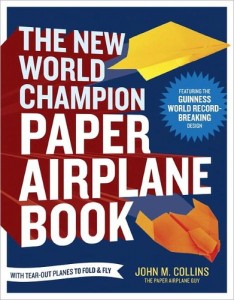John M. Collins is the godfather of the modern paper airplane.
That might not be the sexiest title in the world, but few people have obliterated a world record the way that Collins did, crafting a paper airplane that flew 226 feet and 10 inches, a full 19 feet and 6 inches farther than the previous record holder. And now, Collins is kindly offering you the tools to follow in his footsteps and possibly even break that record.
Collins has written The New World Champion Paper Airplane Book, a guide that features step-by-step instructions on how to fold and throw a variety of paper airplane models, including his record-breaking design Suzanne, as well as an account of the events leading up the day he broke the record.
I hadn’t built a paper airplane since elementary school, and their flight paths usually followed a distinct Hindenburg-ian pattern, so I took reviewing this book as a personal challenge, to see if Collins could fix someone as hopeless as I am when it came to the art of paper flight.
The New World Champion Paper Airplane Book is a serious book about paper airplanes, if such a thing exists, and it makes clear quite early on that Collins did not stumble across his record-breaking design by accident. The first chapter – 12 pages, or about 10% of the entire book – is dedicated to teaching you why things fly, or at least why we think they fly. Words like ‘dihedral angle’, ‘scale effects’, ‘glide ratio’ and ‘sink rate’ are explained and opposing flight theories are discussed, which is certainly not something I expected out of a book detailing a hobby that I practiced when I was 10. But the lesson in aerospace engineering is never dull and it left me with a newfound appreciation for the paper gliders that I was about to be building and the physics that come into play.
After that brief lesson in physics, Collins moves on to the proper way to hold and throw a paper airplane, then details the basic origami folds that will eventually help to construct each aircraft. This could all be a dreadfully boring read, but Collins writes in a light and conversation tone that never drags or gets caught in the weeds, and the hand-holding that he does early on pays dividends later in the process, when you’re four folds deep into a plane and precision is crucial.
Once you’re through the history lesson and folding examples, it’s time to actually build your plane. Each design is broken down into fold-by-fold instructions supplemented by pictures and symbols representing each fold. Even the most basic designs feature a degree of intricacy that your average plane made in the back of a classroom will never see, and I found myself flipping back to the introductory folding section after almost every step to try and remember what each fold was supposed to look like.
My first plane was a sad-looking clunker. Lines weren’t perfect, my nose was slightly squished, and I fully expected it to nosedive upon takeoff, so you can imagine my surprise when it actually flew. Not very far, but farther than anything I had ever built during my childhood. Success!
Emboldened by my maiden flight, I jumped into another build, then another and another, until my floor looked like a miniature airfield. When building a paper airplane, my first instinct was to rush through each fold as quickly as possible, but as I forced myself to slow down and focus on each fold as Collins instructed, subsequent builds of each model yielded progressively better results. My planes might not have been flying 200 feet, but they flew straight and, using the finger-placement and throwing techniques that Collins recommends, I could even get them to veer in different directions on purpose. There is something thrilling about seeing an object fly through the air and knowing that you created it, even if you’re only following directions.
The success of your airplanes will ultimately depend on how much time you’re willing to put into them. Collins’ book can be a quick read and a brief distraction, but if you’re interested in taking it further, there’s a full-blown hobby in these pages waiting to be unlocked. Each plane I built fared better than the last one, and it’s gratifying to see your folding become crisper and your planes fly farther as a result of continued practice.
We tend to think of things like paper-airplane building as something exclusively for children, but don’t let that keep you away from this book. The New World Champion Paper Airplane Book is a good read on its own and, if you’re willing to let it be, a springboard into something so much more.
Rating: 8.5/10
The New World Champion Paper Airplane Book by John M Collins review/ 160 pages, paperback/ Ten Speed Press, March 26 2013
(This book was reviewed with a copy provided by the publisher)
(Cameron Gidari is a freelance writer and the author of Seattle Before8. Follow him on Twitter at @CGidari)

